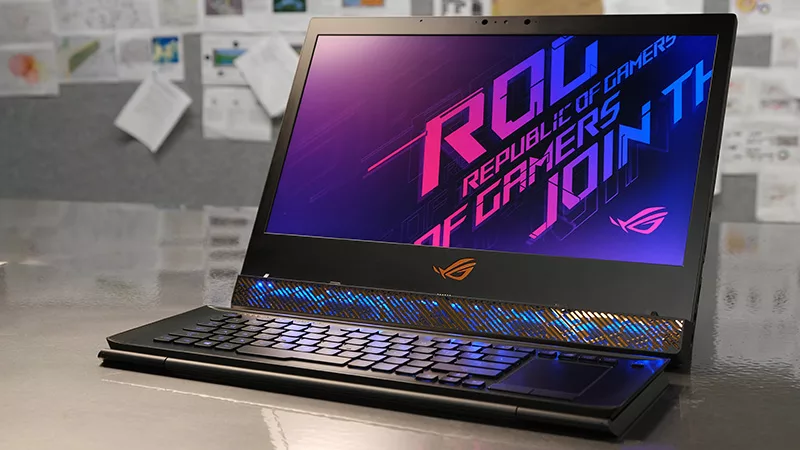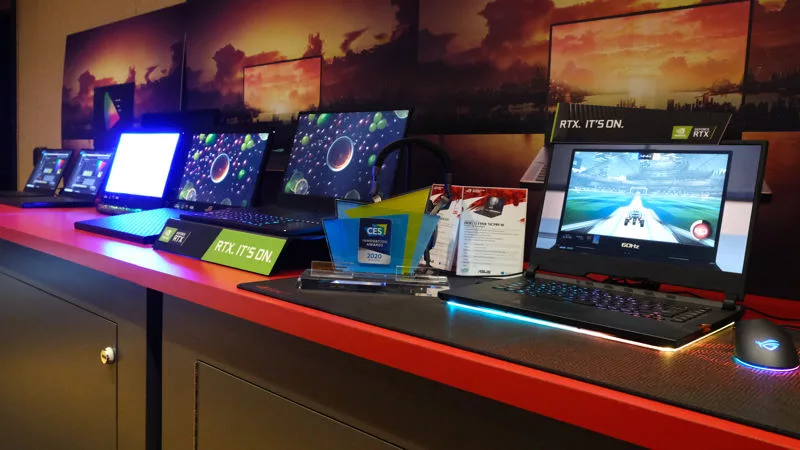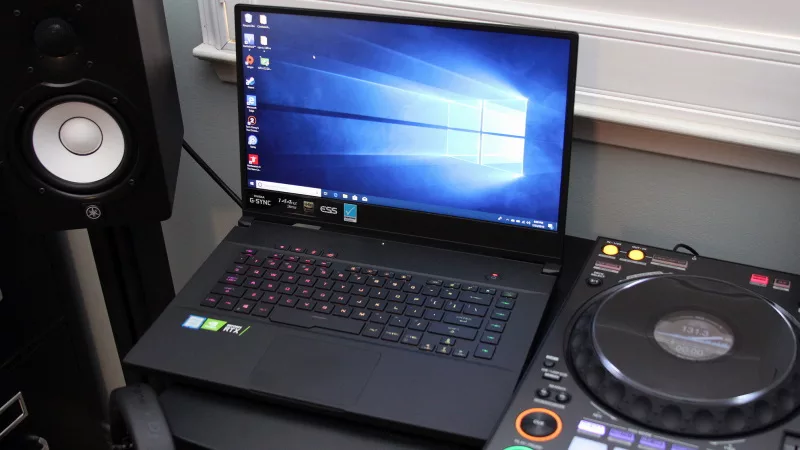HDR, 240Hz, and 4K panels reinforce ROG’s leadership with gaming laptop displays
Display technology provides the canvas of pixels that dictates so much of how we experience games. It paints the vivid colors and sharp details that we see, affects the fluidity of movement that we feel, and controls how clearly we can perceive the world in motion. ROG recognized the importance of cutting-edge displays early on, and for years we’ve been working closely with panel makers to push the limits for gaming laptops.
This collaboration has allowed us to push the industry toward higher refresh rates, faster response times, and slimmer bezels all without sacrificing picture quality. For example, our new GeForce RTX laptop family is filled with gorgeous 144Hz/3ms displays framed by super-narrow bezels in both 15” and 17” flavors. Factory calibration also gives one model professional-grade color accuracy with Pantone Validation.
At CES 2019, we’re diversifying the ROG portfolio with new milestones, starting with our first 4K display featuring thin bezels. It’s joined by the world’s first HDR display for gaming laptops, a visual stunner that brings a billion colors and local dimming together with a blistering refresh rate and response time, and the new champion of all-out speed, a 240Hz beast primed for esports glory. See live demos of all three along with our latest gaming laptops at the ROG showcase in Las Vegas, Nevada from January 7~10.

A history of leadership in gaming laptop displays
Our close relationship with panel provider AUO deserves much of the credit for our ability to consistently lead the competition. In mid-2016, we brought gaming laptops into the high-refresh era with the ROG G752VS at 120Hz. Despite doubling the refresh rate of typical laptops, the IPS-level AHVA panel maintained the excellent colors and viewing angles expected from the technology. The larger 17” display was joined by a more portable 15” version later that year in the GL502VSK, and the same screen eventually went into our very first Zephyrus ultra-slim gaming laptop.
Reaching the next level required an entirely new liquid crystal structure developed with chemical giant Merck. A lot of changes had to be made to get the crystals operating optimally at higher speed. While the old structure branched like a tree, the new one comprises parallel lines that are more difficult to grow. It’s immersed in a liquid with lower resistance that helps the crystals rotate faster with less applied voltage. Getting the right viscosity is critical because the crystals won’t align properly if the liquid is too thin; they need to be perpendicular to the panel to allow light to pass through.
The cell structure and gaps for the crystals are carefully tuned to balance speed with picture quality. Leaving more room for the crystals to move helps them rotate faster, resulting in quicker pixel transitions, but going too far lets more white light leak through, which shrinks the color gamut and contrast range. The cathode and anode use a special material and structure that lowers resistance and crosstalk, but the specifics of the design are a closely guarded secret.
All the work put into the next generation started paying dividends in August 2017, when we introduced the world’s first 144Hz gaming laptop with the ROG G703. The 17” desktop replacement was soon joined by the more portable 15” GL503VS, continuing our commitment to bringing ultra-fast display technology to a broad range of gaming laptops.
Accelerating pixel transitions
Increasing the refresh rate makes gameplay and animation look and feel smoother, but it’s only one part of the equation. The response time determines how quickly pixels can change colors, which affects the amount of blurring or ghosting trailing fast-moving objects. Our first 144Hz gaming laptop displays dropped the grey-to-grey response time down to just 7~9ms, a decrease of 2~3X compared to previous panels. We achieved this by accelerating crystal rotation using an overdrive algorithm that applies higher voltage to intentionally overshoot individual RGB targets.
Driving the pixels too hard can damage the cell structure and introduce other visual artifacts, so tuning the overdrive algorithm is a delicate balancing act. Over time, we've been able to improve pixel response to create an even sharper picture at speed. In April 2018, we debuted laptops with an industry-leading response time of just 3ms, leaving competitors in our wake. This ultra-fast display was available across a full lineup of gaming notebooks based on Intel's mobile 8th Gen Core processors.
Shrink the bezels to maximize the display
Slim bezels were the next frontier. Instead of pulling the trigger early and sacrificing other panel specs to follow the latest trend, we worked with AUO to shrink the bezels without compromise. These efforts culminated at Computex 2018, where we introduced the first 144Hz/3ms display with super-narrow bezels. The ROG Strix SCAR II and Hero II used the slimmer frame to make their 15” footprints more compact, and that was just the beginning. The same panel soon found a home in the Zephyrus S GX531, making the the world's thinnest gaming laptop slim from body to bezel.
Thin bezels make the display more captivating, and the effect is amplified with a larger panel. In August 2018, we introduced a 17” version of the SCAR II based on the same technology, adding another notch to our streak of industry-leading laptop displays. The larger screen also anchors the all-new Zephyrus S GX701 introduced at CES 2019, making slim bezels available with two screen sizes across both ultra-slim and standard laptop form factors.
Expand your dynamic range
Higher dynamic range is the future, and you can see it at CES in the Zephyrus S GX701 and GX531. These laptops are showing off new HDR displays with the same high refresh rate and quick response time as their SDR counterparts, but everything else dialed up to exceed VESA DisplayHDR 400 requirements. The panels support 10-bit color with over a billion distinct shades that make gradients exceptionally smooth. They cover the full BT.709 color gamut and produce lush colors over wide viewing angles.
The backlights blaze up to 500 nits of peak brightness, surpassing HDR400 requirements by 25%, and they go dark enough for dynamic contrast of 4000:1. There’s more intelligence behind the illumination than the VESA spec requires. Instead of lighting the screen evenly, the backlights modulate brightness across individual zones to prevent brighter portions of the scene from washing out darker areas. There are 16 local dimming zones on the 15.6” panel and 15 on its 17.3” counterpart. Both offer impressive range between deeper blacks and brighter whites.
HDR is so new to gaming laptops that the ecosystem isn’t yet firing on all cylinders. This implementation connects the display to the integrated graphics on Intel Core processors, allowing the discrete GPU to shut down opportunistically to extend battery life. The versatile setup uses NVIDIA Optimus technology, but it’s incompatible with G-Sync and unrecognized by the NVIDIA API that many game developers use for HDR. Only games that support the native Windows API for HDR correctly detect that the display can handle high dynamic range. Right now, that’s Forza Motorsport 7, Halo Wars 2, Final Fantasy XV Windows Edition, Shadow of the Tomb Raider, and Monster Hunter: World. We’re working with Microsoft and Intel to encourage developers to support the Windows API in more games.
While the pool of compatible games is set to grow, essential video services are already working. You can enjoy high-dynamic-range content from streaming giants like Netflix and YouTube, among others. We’re still fine-tuning the display with our partners, but its appeal for day-to-day use and general entertainment is clear even at this early stage. Stay tuned for more on our plans to deploy the display in ROG laptops.
Recalibrate for content creation
HDR caters to entertainment, but ROG gaming laptops are often used by content creators and other professionals who need powerful machines for serious production and productivity. Resolution is often king for this crowd, even if it means lower frame rates for gaming, so at CES 2019 we’re showing a version of the 15.6” Zephyrus S GX531 with a new 4K display framed by super-narrow bezels. The panel’s Ultra HD resolution quadruples the number of pixels available with the system’s usual high-refresh Full HD display, enabling exceptional detail for photo and video editing, and it covers 100% of the Adobe RGB color gamut, providing a wider palette of colors than standard sRGB. The backlight is capable of cranking out 400 nits of brightness for better visibility outdoors and under intense lighting.
Color accuracy is extremely important for creators, designers, and even gamers who want to see graphics as the developers intended. The new ROG Zephyrus S GX701 straddles the line between gaming powerhouse and professional workhorse with a 144Hz/3ms Full HD panel that’s calibrated at the factory to guarantee accuracy. ProArt™ TruColor Technology ensures that each one meets stringent X-rite Pantone Color Validation requirements. The Zephyrus S GX531 will be available with similar calibration and validation for its equivalent FHD display, and the same will apply to the 4K AUO panel from our CES demo.
Brace yourself for 240Hz
Although much of our leadership with laptop gaming displays has come from AHVA panels developed with AUO, we also work with other partners who share our passion for pushing the envelope. At CES 2019, we’re raising the bar for speed again by being among the first to have a laptop with an insanely fast 240Hz display. Ultra-high refresh rates like this are extremely important for esports pros and competitive amateurs looking for an edge. In fact, top players and events often demand 240Hz for tournament machines. This new laptop panel matches the refresh rate of the fastest desktop monitors used in esports competition.
The panel is produced by Sharp and uses IGZO technology, which offers a range of refresh rates with low power consumption that’s ideal for mobile applications like gaming laptops. Its combination of slim bezels and insane speed are a perfect fit for the esports-oriented ROG Strix SCAR II used to demo the display in our CES showcase. The 240Hz panel will find a more permanent home later this year in a future ROG laptop.
Get a glimpse of the future today
For years, ROG has been at the forefront of gaming laptop displays. We’ve pushed the adoption of higher speeds and haven’t sacrificed vital specs to jump on new trends. With new HDR, 240Hz, and 4K displays, we’re expanding to offer a broader range of options to meet the needs of gamers, power users, and professionals. See our displays in action at the ROG showcase at CES 2019 in Las Vegas, Nevada from January 7~10.
ROG announced tons of new tech at CES. Check out this article to see all of our announcements in one place.


